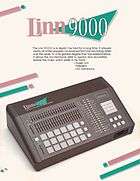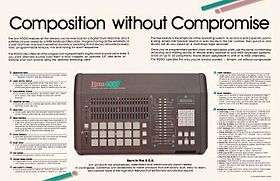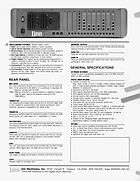Linn 9000
| Linn 9000 | |
|---|---|
 Linn 9000 integrated digital drum machine and MIDI keyboard recorder. | |
| Manufacturer | Linn Electronics |
| Dates | 1984-1986 |
| Price | US $5,000 ($7,000 fully expanded) |
| Technical specifications | |
| Polyphony | polyphonic 13 voices |
| Timbrality | multitimbral 18 voices |
| Synthesis type | 8 bit Digital Samples / 11 kHz - 37kHz |
| Storage memory | 100 Drum Sequences, 100 MIDI Sequences - 10,490 notes |
| Effects | Individual level, pan, tuning for all sounds |
| Input/output | |
| Keyboard | 18 large (1.25 inch square) velocity and pressure sensitive rubber pads |
| External control | MIDI In/Out/Thru, Foot Switch x2, Foot Controller x1 (hi-hat), Sync Tone In/Out, trigger outputs x2, trigger inputs x6 |
The Linn 9000 is an electronic musical instrument manufactured by Linn Electronics as the successor to the LinnDrum. It was introduced in 1984 at a list price of $5,000, ($7,000 fully expanded) and about 1100 units were produced.[1]
It combined MIDI sequencing and audio sampling (optional) with a set of 18 velocity and pressure sensitive performance pads, to produce an instrument optimized for use as a drum machine. It featured programmable hi-hat decay, 18 digital drum sounds, a mixer section, 18 individual 1/4" outputs, an LCD display, 6 external trigger inputs and an internal floppy disk drive (optional).[2] The Linn 9000 had innovative and groundbreaking features[3] and would influence many future drum machine designs.[4][5] But chronic software bugs[6][7] led to a reputation for unreliability and contributed to the eventual demise of Linn Electronics.[8][9]
The Linn 9000 would get a new lease on life when Forat Music and Electronics purchased Linn's remaining assets,[10] fixed all of the bugs,[11] added new features[12] and dubbed it the Forat F9000.
History
The Linn 9000 would be Roger Linn's first attempt to create an integrated sampling/sequencing/MIDI work station. He would draw heavily on the Linn 9000 and the Sequential Circuits Inc. Studio 440 when he designed the Akai MPC60,[4][5] released in 1988.
The Linn 9000 was plagued with problems from the beginning.[6][7]
On early models, the power supply over-heated the CPU and had to be replaced under warranty. The original Linn 9000 operating system was mostly written in an esoteric high-level programming language called FORTH with some machine language. In early versions, some of the FORTH code produced unacceptable delays in user interface functions and was rewritten in machine language. But the operating system had numerous bugs and it was common for the machine to lock-up and lose data.
Linn attempted to debug, rewrite and enhance the operating system. But the 64K code space memory segmentation in the Intel 8088 was perceived as an insurmountable limitation on memory that left no room for new features. Further software development was abandoned.
The flawed Linn 9000 operating system was also used in the LinnSequencer,[13] a rack mount 32 track hardware MIDI sequencer introduced by Linn Electronics in 1985. As a result, both machines earned a reputation for being notoriously unreliable. In addition, the same operating system was used in the LinnDrum Midistudio, a rack mount version of the Linn 9000 that was planned to be the successor to the 9000, but was never released.
These issues contributed to the eventual demise of Linn Electronics in 1986.[8][9] Forat Music and Electronics purchased Linn's remaining assets,[10] completely reinvented the Linn 9000,[12] fixed all of the bugs[11] and dubbed it the Forat F9000; released in 1987.
Features
The Linn 9000 has eighteen 8 bit 11 kHz ~ 37 kHz digitally sampled drum sounds: bass, snare, sidestick, hihat, two crash cymbals, two ride cymbals, four toms, cabasa, tambourine, high and low congas, cowbell and clap.
The Linn 9000 had many firsts.[2][3]
In addition to being the first drum machine to incorporate a MIDI sequencer, it was the first drum machine with custom sounds, sampling capability (optional), a floppy disk drive (optional) and an LCD display.
The programmable hi-hat decay is a unique feature[14] that provides seven open hi-hat positions in addition to the closed hi-hat, allowing for subtle and expressive performances.
The Linn 9000's most distinctive feature was 18 large (1.25 inch square) velocity and pressure sensitive rubber pads. Pad pressure is used for the Note Repeat feature. If you hold Timing Correction and apply continuous pressure to a pad while in record mode, that note is automatically repeated at the Timing Correction note value setting. The velocity (volume) level of each repeated note is determined by the amount of pressure applied at the time the note is played. Similar rubber pads would be seen on many subsequent drum machines and controllers including the Akai MPC60[4] and the Akai MPC4000.[5]
Standard Features
- 32 track MIDI hardware sequencer
- 18 digital sample drum sounds
- 18 rubber velocity and pressure sensitive pads
- Note repeat
- Programmable 8 position hi-hat decay
- A mixer section providing real time control over volume, tuning, and pan
- 18 on-board sliders and pan pots
- 18 individual 1/4" outputs
- Back lit LCD display screen
- Online help
- Cassette Interface: mic-in, line-in, line-out
- 6 external trigger inputs (expandable to 12)
Optional Features
- 12 external trigger inputs (6 standard)
- Internal 3.5" double density floppy disk drive
- Digital sampling capability
- Up to 4 custom sounds
- SMPTE (never deployed by Linn)
Brochure (1984)



Architecture
The Linn 9000 circuitry is deployed as a mother board with 14 slots. Daughter boards are used to deploy standard and optional features, with slots on the back panel resembling PCs of the time. It uses the Intel 8088 CPU chip.
Discography
References
- ↑ "Past Products Museum". Roger Linn Design.
- 1 2 "Specifications". Total Trash. The Linn 9000 Home Page.
- 1 2 "...the Linn 9000 remains one of the true innovative designs of it's decade.". Total Trash. The Linn 9000 Home Page.
- 1 2 3 "Roger Linn then began a design collaboration with Akai, drawing heavily on the Linn 9000 and Studio 440 concepts, resulting in the MPC60.".
- 1 2 3 "Brothers, Sisters, and Cousins: Similar Drum Machines". Total Trash. The Linn 9000 Home Page.
- 1 2 "...but bugged by many OS troubles and technical issues.". Polynominal.
- 1 2 "...it was plagued with operating system bugs...". Total Trash. The Linn 9000 Home Page.
- 1 2 Linn, Roger. "What happened? We simply ran out of money and were unable to get more. Why? There were a number of reasons. The 9000 had technical problems early on and was expensive to re-engineer, manufacturer and service; we had strong competition; we had no investment financing; and we were experiencing all the classic "growing pains" of a new business.". Bobby Nathan's Keyboard Magazine "In The Studio" Article #17 "What Happened to The Linn 9000".
- 1 2 "one the most unreliable and buggy machine ever made, in fact this ground-breaking and expensive project bankrupted the Linn company.". Polynominal.
- 1 2 "Then in 1986 Forat Electronics Corporation was born after purchasing Linn's remaining assets...". Forat Electronics - History.
- 1 2 "In the F-9000, all old software bugs of the old Linn 9000 are fixed,...". Vintage Synth Explorer.
- 1 2 "They [Forat Electronics] have since re-invented the Linn 9000 themselves and released the Forat F9000". Vintage Synth Explorer.
- ↑ Linn, Roger. "...we sent out one copy of the new version 5.17 software ROMS for the 9000 and LinnSequencer...". Bobby Nathan's Keyboard Magazine "In The Studio" Article #17 "What Happened to The Linn 9000".
- ↑ Ballard, Glen (March 1, 2003). "I like the way the Linn feels, more than anything, especially the Linn hi-hat, which has eight positions of openness, and I have yet to find this in any other box or sequencer.". Sound On Sound. Retrieved January 28, 2015.
External links
- http://www.rogerlinndesign.com - Roger Linn Design
- http://www.forat.com/ - Forat Music and Electronics Corporation
- http://sourceforge.net/projects/linn9000fs - Linn 9000 filesystem
- http://www.discogs.com/artist/355901-A-Linn - A. Linn Discography at Discogs
- http://www.bobbynathan.com/key17.htm - Bobby Nathan's Keyboard Magazine "In The Studio" Article #17 "What Happened to The Linn 9000"
- http://www.totaltrash.com/linn9000/ The Linn 9000 Homepage - Total Trash
- http://www.vintagesynth.com/linn/linn9000.php - Vintage Synth Explorer - Linn Electronics Linn 9000
- https://latedragilmore.wordpress.com/2013/09/18/electronic-music-innovations-linn-9000-linndrum-and-lm1/ - Linn 9000, LinnDrum and LM-1: Electronic Music Innovations
- http://www.polynominal.com/linn-9000/ - Linn 9000 page: free samples, review and audio demos.